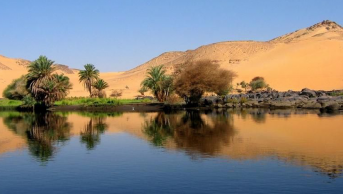Handle with Care! The Tragedy of the Tabqa Dam

Big structures are the perfect candidates for big achievements, but also failures. The Tabqa Dam is the biggest dam in Syria and it is also one of the biggest in the Middle East. It has now become one the hotspots in water management politics in the region. Chasing Daesh, the American-led coalition conducted airstrikes which also hit the Tabqa Dam, in late March.
Behind the dam lies the then Lake Assad (now called by some as the Revolution Lake), the largest reservoir in Syria with some 9 billion cubic meters of water. It was completed between 1968 and 1973, with the aid of Soviet Union. At the time of inception, it appeared as a triumph of the Assad’s regime over not only the otherwise inhospitable geography, but also over poverty as well as regime’s opponents. It was a perfect exemplar of the era of “hydraulic mission” in the Middle East: water was tamed through a colossal engineering structure and utilized for wealth of the people. Although the expectations from the dam were huge, it fell short of reaching its full potential.
The dam was neither able to produce the amount of hydropower that it was supposed to, nor it was complemented by additional works with a view of reaching its goals regarding irrigation. Proposed irrigation systems around Tabqa were also negatively affected by high gypsum in the soils, and the problem of salinization. Thus, the Tabqa dam was born semi-dead. In order to compensate the inadequacies of the Tabqah Dam, Syrian regime constructed number of dams including the Baath Dam and the Tishrin Dam.
Furthermore, it also created a diplomatic crisis when Iraq protested the very limited amounts of water released from Euphrates during the filling of the dam. The crisis escalated and at a time two countries found themselves at the brink of a war. The war was averted thanks to Saudi Arabia’s –and to some extent Soviets’- mediation.
From a technical perspective, the dam is so inefficient in terms of water losses due to evaporation. Looking at Google Maps, one may presume that reservoirs of Tabqa Dam and Ataturk Dam in Turkey have similar capacities. However, Ataturk Dam has a 48 billion cubicmeters of water with a surface area of 817 square kilometers, while Tabqa Dam has only 9 billion with a surface area of 615 square kilometers. Therefore, the reservoir of Tabqa Dam is very shallow making it susceptible to intense evaporation losses, which is also exacerbated by the high temperatures across the Euphrates Valley in Syria and Syrian desert in the south. Contrast is even bigger with the dams further up North. For instance, while annual evaporation is 1.3 billion cubic metres at Tabqah Dam reservoir, it is only 0.48 billion cubic metres per year at Keban Dam reservoir which has approximately the same surface area with that of Tabqa.
The Tabqa Dam has become a war zone during the internal conflict in Syria, particularly with the rise of Daesh. Being just forty kilometers west of the Daesh’s de facto capital, Raqqah, the dam was so strategic for entire central Syria. It was occupied by Daesh in 2014. Daesh’s operation of the dam was definitely behind standards. However, today’s risks might be more imminent than the previous period.
The bad physical condition of the dam after the bombing was reported in various news agencies. It was told that one of the control towers had completely been burned. According to some experts, the dam should soon be repaired. These experts further warn that if this need for urgent repair is dismissed the dam might fail causing a tremendous catastrophe for the whole Euphrates Valley south of the dam.One of the additional risks was the high water level and continued flow of water from North, pressurizing the dam structure. Certainly, these observations render allegations against Turkey obsolete. Turkey was being accused of cutting Euphrates’ water off from being released to Syrian territory. Finally, another risk is the continuation of fighting around the dam site which makes repair works very difficult. On the other hand, some experts contend that the Dam is vast enough to stand firm against a small accidental shelling. In fact, it is a more than 4 kilometers long and 20 to 510 meters wide earth-fill dam.
Recent partial failure of the Oroville Dam in California, US, is a reminder of how terrible the results of such a destruction in the Tabqa case can be. In the Oroville Dam case early this year, damage was tried to be minimized through mandatory evacuation of nearly two hundred thousand people. At a certain time, average discharge from the dam neared 3000 cubicmeters per second. Tabqa Dam is nearly 1.5 times of the Oroville Dam. Estimates states that the initial flood wave can reach 50 meters high. Besides, there are legitimate doubts whether dwellers in the Daesh controlled city of Raqqah can have a timely access to warnings.
To conclude, fighting with Daesh created paradoxical situations, particularly with regard to water issues. The first theater was in Mosul, where siege of the city limited people’s access to food and water and thus threatened lives of hundreds of thousands. Now, fighting with Daesh near Tabqa is creating another “boomerang effect”. Forces fighting against Daesh should handle the issue of the maintenance of critical water infrastructure very carefully.









